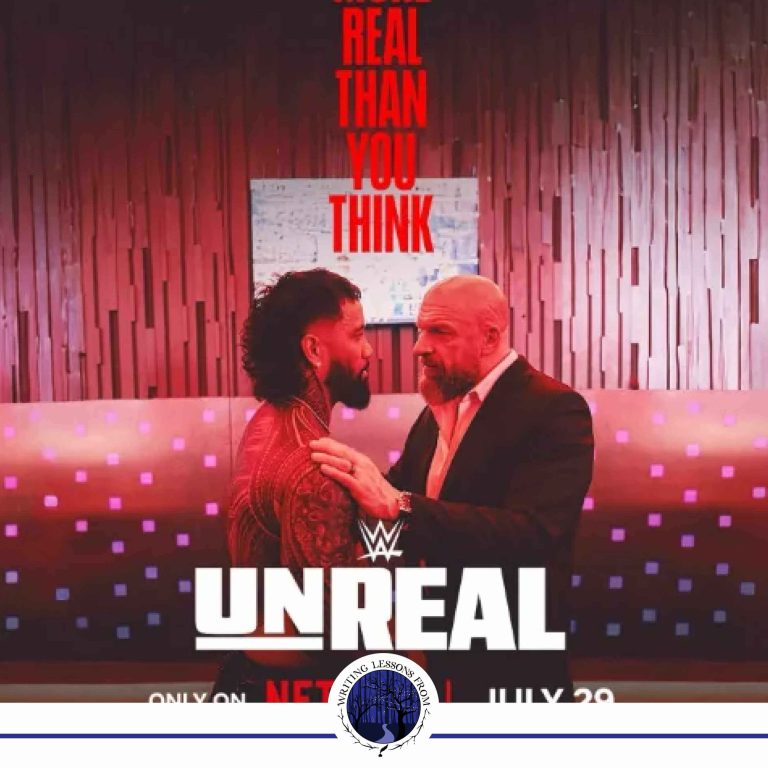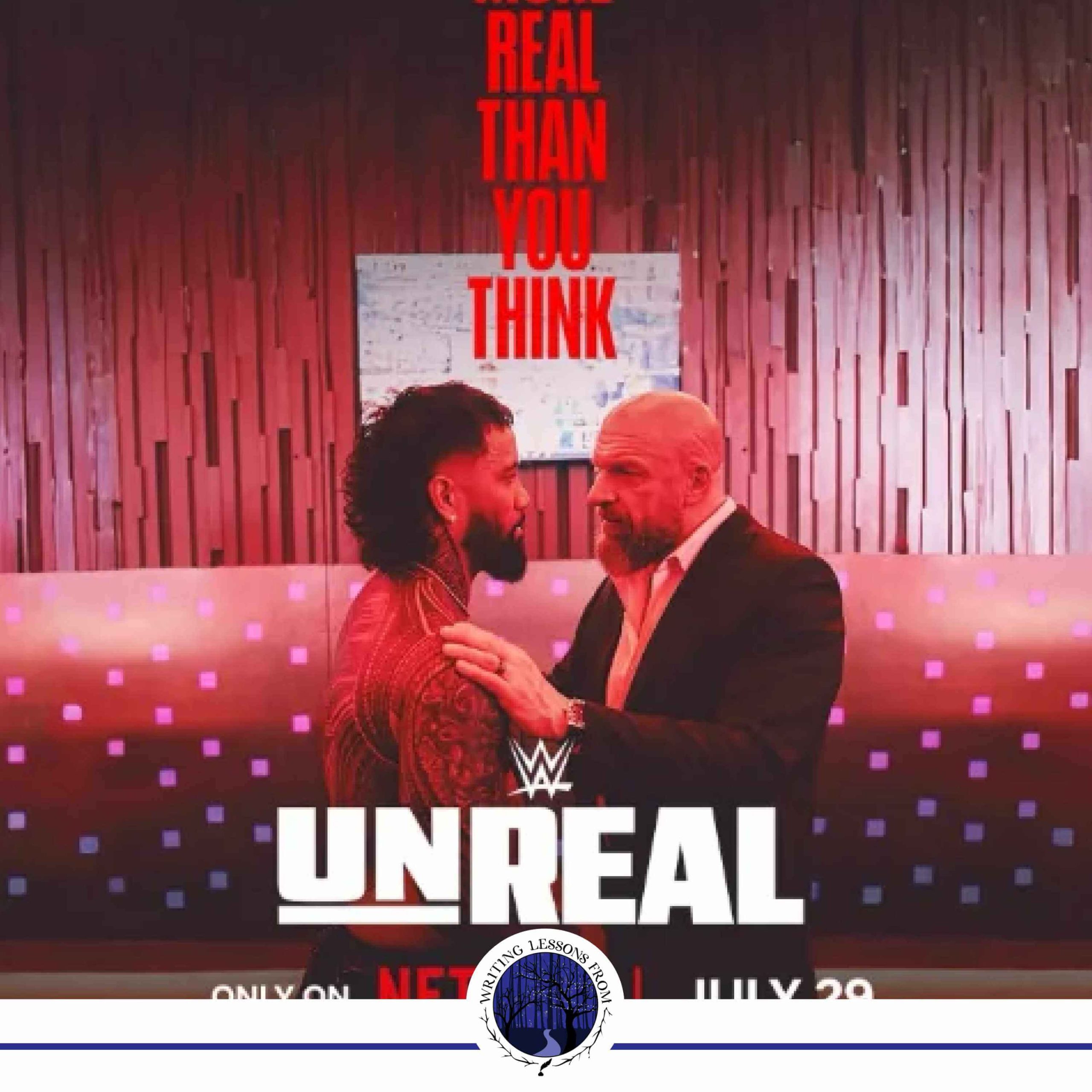Writing Lessons From... Unreal aka Creating a Billion-dollar Soap Opera
Listen to the blogcast of this episode:
There are a lot of things in this world that my husband has introduced me to.
His own language (no one in my family can now say ‘hummus’ properly), that funny noise I can’t make and, of course, wrestling.
I don’t remember when I caught the wrestling bug, but it was pre-pandemic, which is how we do timings now, right? I also don’t remember how long it lasted, but here I am, with a working knowledge of wrestling without the regular watching thereof.
What’s that? Wrestling isn’t real?
Sure, okay, in what way do you mean?
Because those hits are real. The risks are real. Wrestlers have died in the ring, many more have broken their necks and ended their career with one wrong landing.
Annoy your opponent in real life, act unprofessional, and you can bet those punches will be real hard too.
But the rest of it?
Wrestling is a show, it’s a pantomime, a soap opera. There are villains (heels) and heroes (baby faces).
There are stories.
And that’s where we’re going today.
Behold! The following contains minor spoilers of WWE that has already happened but some spoilers in general for the documentary Unreal.
(Unreal is available on Netflix, as is all of WWE wrestling these days. In fact, their move to Netflix and the closure of their own subscription service is documented in this documentary!)

Even if you’re not a wrestling fan, if you’re a storyteller, I highly recommend watching Unreal.
WWE (it used to be WWF, and if you remember that, we might be the same age) has a somewhat controversial history. Let’s move past that, from its small beginnings as a family run company, flash through the political incorrectness, the misogyny, the sexual predator who started and ran the company but is apparently no longer involved.
These days one of the top cats at WWE is Chief Content Officer Triple H (Paul Levesque). The head of the writers’ room, in Unreal Triple H lets us see how stories are put together in WWE, and some of the things he said were pure gold.
Before we get into the writing lessons, I just want to shout out Bianca Belair, an incredible wrestler who makes her own outfits! Seriously, watch Unreal and you’ll see her still sewing pieces together after having stayed up all night before a match.
Her outfits are incredible, and she obviously has more talent than just being an amazing athlete.
Anyway, writing…
In Unreal we get to see how the storylines in WWE work, and how they’re put together. The focus is mostly on the retirement year of John Cena and how they’re going to make the most of this massive WWE legend before he leaves to become a full-time actor.
It never occurred to me how much pain he might be in after such a fulfilling career. I’m actually quite glad he’s retiring from wrestling if it’s causing him pain just to do his signature move, and he’s a phenomenal actor, as I mentioned a couple of weeks ago when we looked at Peacemaker.
(Side note: I was about to apologise here, I’m using so many words like fantastic and amazing, but the truth is I have so much respect for wrestlers. Their work ethic leaves me in awe. Not only can they not eat as much cake as I want to, they have to work all the time, often for little money. That includes travelling, not sleeping much and taking beatings. Watch any wrestling documentary – and there are a few on Netflix – and you’ll see what I mean.
Even when you’re a big star, the work patterns are insane, and you still might get trodden on. I was shocked by how CM Punk has been treated in the past, I always assumed he was a big star and got his way. His story in Unreal is incredibly moving.
So much of what wrestlers do, even the big WWE Superstars, is down to confidence, mindset and hoping to catch that big dollop of luck.
Quite similar to being a writer in many ways. Except we’re allowed all the cake.)
Back to Triple H, who sent off dinging light bulbs in my head when he said that creating a WWE story was all about following the ‘what ifs’.
The thing about storytelling in wrestling is that the fans are FANS. All caps. They know these people, they don’t want predictable stories but they’re so good at predicting them.
It’s a problem that all storytellers face. We want to keep our readers guessing, we want to keep them on their toes. We want to surprise and amaze.
By following the ‘what ifs’, we can find a new angle or action that our readers might not be expecting.
One exercise to do this, especially when you don’t have a room of people to bounce ideas off, is to open a document or grab a piece of paper and write down every single idea you have for a specific thing. It could be a scene, an outcome, the next turn in your plot. Whatever you’re stuck on.
Keep writing the ideas. Until you start to have to really think to come up with new ideas.
What if this happened?
What if that happened?
What Triple H is saying is that you have to keep exploring by following these lines.
What if that happened, so then what if this happened?
Build the ideas together, merge them, let them lead into new things, and then see what other new ideas and new ‘what ifs’ spark from there.
That’s when you get some of the magic; the fresh ideas your readers just weren’t expecting.
As Triple H says, ‘If it becomes predictable, you have to pivot.’
If your ideas are feeling stale, try flipping the whole thing on its head. Try the most outrageous ‘what if’ and then follow it to see what magical places it could take your characters.
Of course, it might lead to a dead end. That’s when you go back and try the next ‘what if’, the next turning on its head, the next twist. Follow it to the end of the line.
I once saw a thing online – you might have seen it too – that sometimes daydreaming is spending an hour running through a story only to reach the end and say, scrap that! Let’s do it again but this time, slightly to the left.
That really sums up storytelling for me.
The other key to WWE’s storytelling is building the surprise.
So much of their business is pinned on the audience not knowing what’s coming next. Getting that massive reaction of surprise is part of what builds the characters in the ring and gives the wrestlers the adrenaline rush to take those hits.
Make as many twists as your story dictates, keep the mystery going, surprise your readers.
Still, as Triple H points out, you always need to keep the audience satisfied. That means knowing when to surprise your readers and when to keep the predictability.
For example, put twists into a romance novel but always have the happily ever after.
Turn John Cena into a heel for the first time in his long career, but make sure he turns back into our hero before too long.
There are expectations to be met in storytelling, and finding the balance between the mystery, the surprise and the overall satisfaction is a difficult one. Find that line, though, and there’s no other feeling quite like knowing just how good and complete you made that story.


